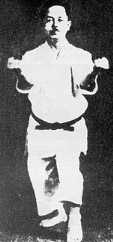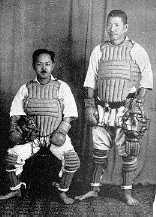|
Karate originated as a martial art thousands of years ago and was
brought to Japan from China, Taiwan and Okinawa. Many of the famous
Karate-ka, or Bushi, as they were known in Okinawa, experimented and
developed their skills in such provinces as Shuri, Naha and Tomari.
But unlike Judo and Kendo, Karate was a secret art, unknown to the
general public. There was no fixed system until approximately 1907,
when Yasutsune Itosu of Shuri and Kanryo Higaonna of Naha -- both of
whom are regarded today as two of the most influential teachers of
Okinawan Karate -- gained a good following for both of their own
special styles.
Kenwa Mabuni, who had studied under both Master Yasutsune Itosu and
Master Kanryo Higaonna, devised the Shito-Ryu system. Born in 1889,
Mabuni was the 17th generation son of a famous samurai named
Onigusuki. Mabuni was keenly aware of the accomplishments of his
brave ancestors and, wanting to overcome poor health, began
intensive karate training at the age of 13. He also studied weapon
techniques of the Bo, Sai, Tonfa, Kama, and Nunchaku.
After learning from other masters like Master Aragaki and Master
Matsumura and by mixing the teaching of Master Itosu and Master
Higaonna, he developed a new system, originally named 'HANKO RYU'
(Half-Hard style), but later changed it to reflect the deep respect
he felt towards his two great masters and called his new system
Shito-Ryu. (The Japanese government's martial arts sanctioning
organization, the Dai Nippon Butoku-Kai, began to demand the
different groups applying for membership, be more specific in the
description of their Karate systems, and pressured them to name
their systems).
The name 'Shito' is the combination of 'shi'
 and 'to' and 'to'
 , the
two first characters of the names of Master Itosu , the
two first characters of the names of Master Itosu
 and Master Higaonna and Master Higaonna
 . .
In 1929, Master Mabuni made a permanent move to Osaka to teach at
universities and police departments. Over the next few years, Master
Mabuni dedicated himself to the further development and promotion of
Shito-Ryu Karate-do in the Osaka area. He was faced with an
extremely difficult task due to the unwillingness of the population
to accept him or this strange looking system of self defence,
resembling an ancient 'Okinawan-Fist Dance'. In order to bring
Shito-Ryu to the general public's attention, Master Mabuni would
perform many demonstrations where he would break bricks and boards
to show the power of karate. Continually trying to gain acceptance
of his art, Master Kenwa Mabuni would give free instruction at
various police stations across western Japan.
Shito Ryu Karate-do became more accepted after this time, and
Master Mabuni began to teach many students at his home and at many
Universities that were forming clubs. Among his many students
was his son Kenzo Mabuni, Kosei Kuniba (founder of Seishin Kai),
Chojiro Tani (founder of Tani-ha Shukokai), Ryusho Sakagami
(founder of Itosu-Kai), Yoshiaki Tsujikawa, Ken Sakio, Jun-ichi
Inoue, Manzo Iwata, Toshiyuki Imanishi, Tokio Hisatomi and Ryusei
Tomoyori. At first he taught his own students pure Shuri-te, then
pure Naha-te, but he also gave instruction in other master's styles.
In Japan, Shotokan-Ryu, Wado-Ryu, Goju-Ryu and Shito-Ryu are the
four main styles of Karate. Shito-Ryu is the style that preserves
most of the original Shuri-te techniques, compared with other styles
such as Shotokan and Wado. It also preserves original Naha-te
techniques together with Goju, although each style places emphasis
on different points. Technically, Shuri-te and Tomari-te have rather
fast and straight movements, while Naha-te has circular and supple
movements.
Master Mabuni died in his 64th year on May 23rd 1952, but his
system remains one of the four major styles in Japan.
|
 'Shito-Ryu'
'Shito-Ryu'
 Master Kenwa Mabuni
Master Kenwa Mabuni
 Master Kenwa Mabuni wearing protective equipment
Master Kenwa Mabuni wearing protective equipment
|